It’s that time of the year — quarterly planning season. This is your chance to map out your business’s trajectory, one quarter at a time.
Unfortunately, the decisions, data, and deadlines involved in quarterly planning can feel like a maze.
The good news? We have a number of strategies to help you make the most of this task. This article discusses all that and more.
What is quarterly planning?
Quarterly planning is the process of planning your business activities and objectives for the next three months. It divides the year into four segments, each with its own set of goals, strategies, and review processes. It's a great way for businesses to set short-term objectives that contribute to the year’s broader goals — and keep track of their progress along the way.
Quarterly planning vs. annual planning
While quarterly planning sets short-term goals, annual planning focuses on long-term goals for the year. The objectives you set in your quarterly planning sessions should support and advance your yearly ambitions.
Quarterly plans are easier to adjust than annual ones because they don’t affect the long-range trajectory as significantly. In contrast, because annual plans focus on a broader vision, they offer less flexibility for mid-course corrections.
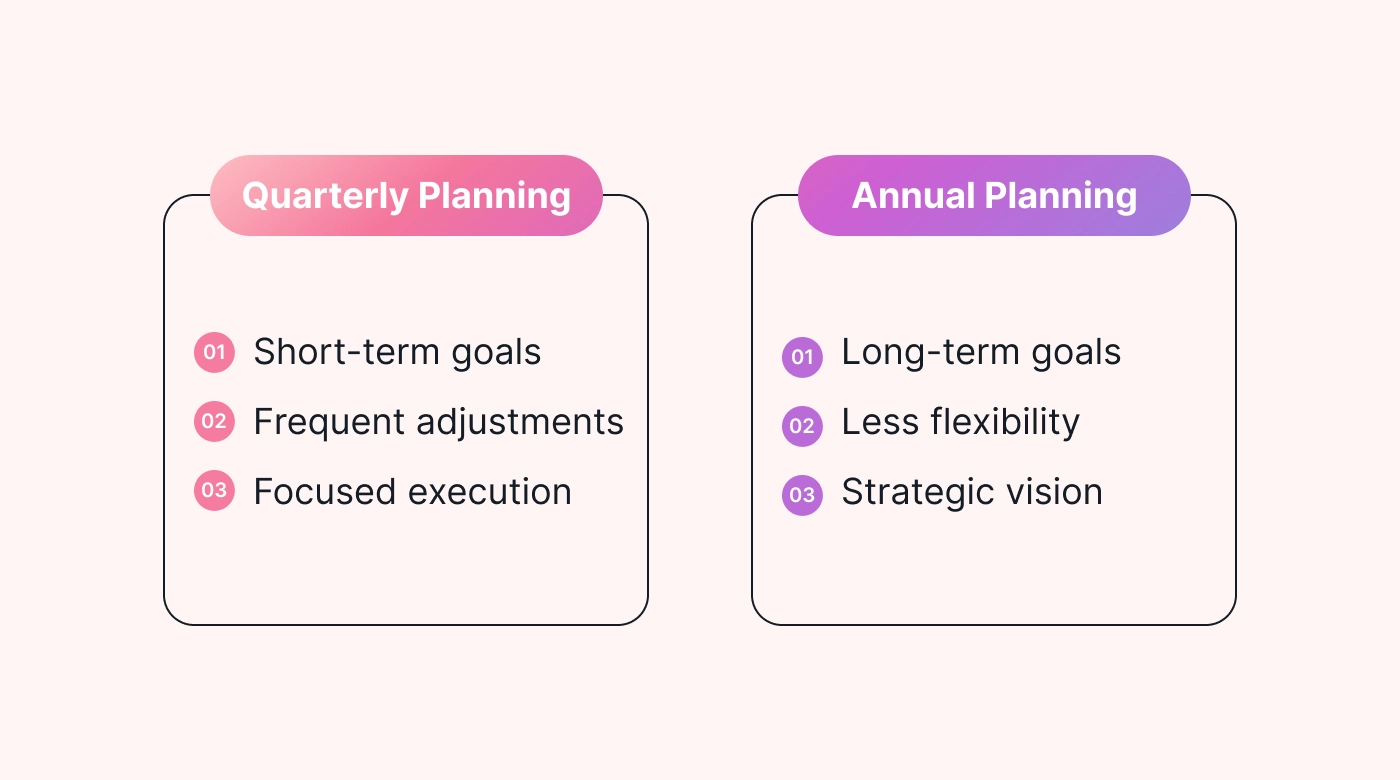 |
Benefits of quarterly planning
Quarterly planning breaks down a company’s objectives into manageable sections. So, instead of being overwhelmed by year-end goals, your team has a clear direction on what they need to do throughout the year in order to achieve their annual goals.
Evaluating their progress and adjusting their strategies at the end of each quarter help your team remain agile and respond proactively to any market changes or operational shifts that come up.
What to include in a quarterly plan
Your quarterly plan doesn't need to be overly complicated, but it should include the following:
- Specific quarterly goals: This section outlines measurable and achievable objectives for the quarter. They should always align with and complement your business’s long-term vision and strategy.
- Budget allocation and financial planning: Plan out how your financial resources will be allocated for the quarter, including both expected expenses and revenue projections. It’s also a good idea to include contingency plans for unexpected financial situations.
 |
- A breakdown of key projects and initiatives: Include major projects and key initiatives planned for the quarter and their expected outcomes. Remember to explain each project’s importance to the company’s long-term goals.
- Resource management and team assignments: Allocate all your resources across projects and assign specific roles and responsibilities to the most suitable team members.
- Milestones and performance metrics: Set clear milestones for tracking progress within the quarter. Defining your key performance indicators (KPIs) will also help you measure your team’s quarterly progress and performance.
7 best practices to maximize your quarterly planning process
To optimize your quarterly planning outcomes, try incorporating these seven best practices into your planning process:
1. Use goal-setting frameworks
Goal setting helps you determine your team’s direction and success. But vague, unattainable objectives don’t work. Instead, set SMART goals — goals that are specific, measurable, achievable, relevant, and time-bound.
Once you set your SMART goals, measure them against your project progress with Motion. Our platform allows you to track your progress in real time. You see where you stand in relation to your objectives, which helps you stay accountable.
2. Identify your team’s strengths
Knowing what your team members are good at will improve how you allocate resources and delegate tasks. Conducting a skill and resource audit helps you understand each individual’s expertise and current workload.
A simple audit can be easily done by reviewing past project performances, gathering team feedback, and evaluating current responsibilities. And setting one-on-one meetings can give you even deeper insights into each team member’s skills, aspirations, and areas for improvement.
By understanding your team’s strengths, you can assign tasks that not only meet their skill sets but also align with their interests.
With Motion, you won’t have to manually assign and track tasks. The software automatically delegates tasks to the most suitable team members based on everyone’s availability and schedule. Talk about optimizing the team workload!
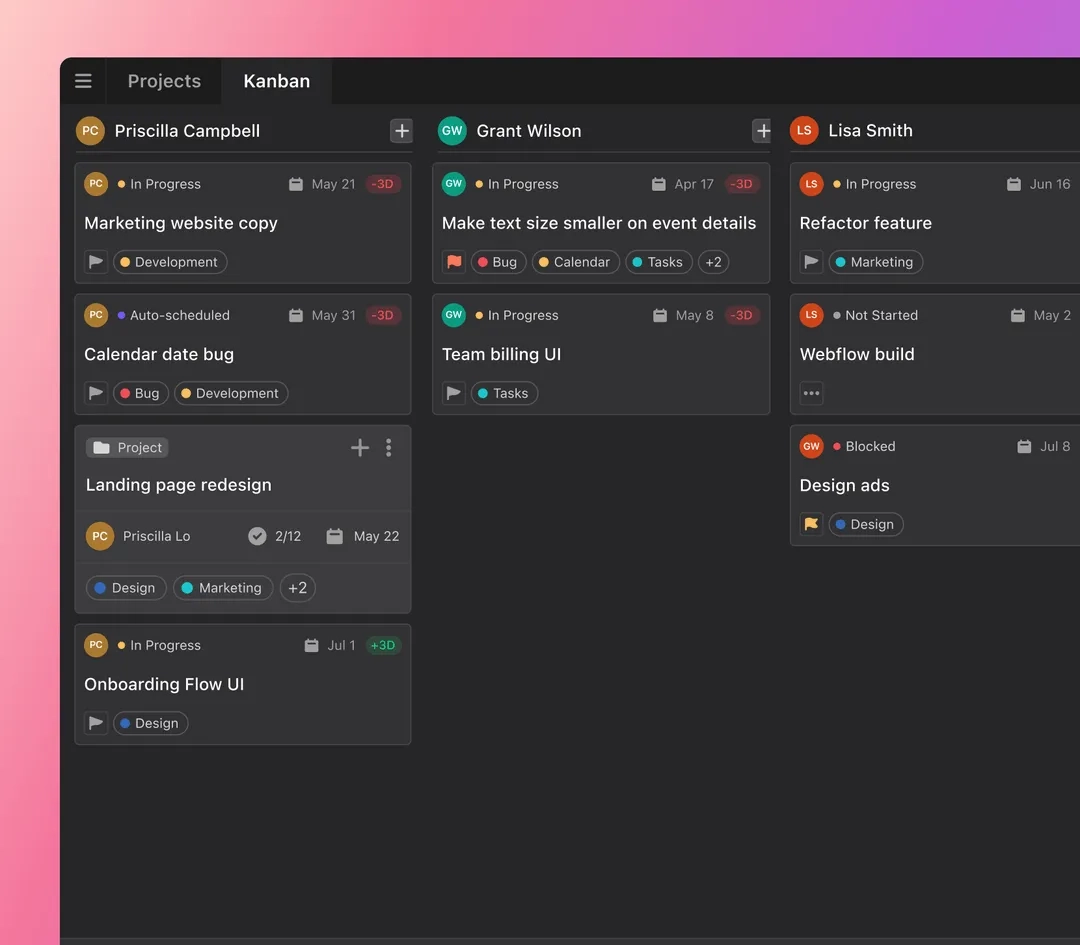 |
3. Work backward from your goals
Sometimes, it’s more effective to work backward from your goals. Start with the most important objectives or desired outcomes and determine the necessary steps to achieve them. You’ll soon figure out what your team needs to do every quarter to reach them.
For example, if you plan to increase revenue by 20% this year, you can break this goal down into quarterly targets for sales growth, customer acquisition, or product launches.
It becomes much easier to assign specific projects and tasks once you understand the incremental milestones that contribute to the larger goal.
4. Make communication easy and clear
Did you know that communicating with coworkers takes up 72% of the work week? This shows just how important it is to maintain clear and efficient communication.
Good team communication leads to better project results because everyone on the team stays informed, engaged, and on the same page.
Centralize and simplify your communication channels to make collaboration effortless. With Motion, you can communicate with your team directly on project boards. Each conversation thread is directly linked to the project, making it faster and easier for everyone to stay updated on progress, decisions, and any changes that are made. No need to jump between chats.
 |
5. Try a war game exercise
By “war game,” we don’t mean getting into a fight — we mean stress-testing your quarterly plan against multiple potential outcomes.
A war game exercise is a simulation tool that helps your team identify possible challenges and refine your strategies in response. It’s an effective way to improve strategy development and decision-making skills because it forces your team to think critically to solve problems. As a result, your team is better prepared for whatever the future holds.
6. Include cross-functional teams
Working in silos doesn’t cut it anymore. More and more businesses are recognizing the benefits of cross-departmental collaboration. In fact, 83% of digitally maturing companies use cross-functional teams.
Including cross-functional teams in your quarterly planning process gives you new perspectives from different departments. The planning process becomes more comprehensive since every angle of the business is thought out.
Motion makes it easy to work across departments. Our team calendar gives you visibility into what everyone — including those in different departments — is doing. This transparency keeps teams aligned, improving communication and collaboration in the planning process.
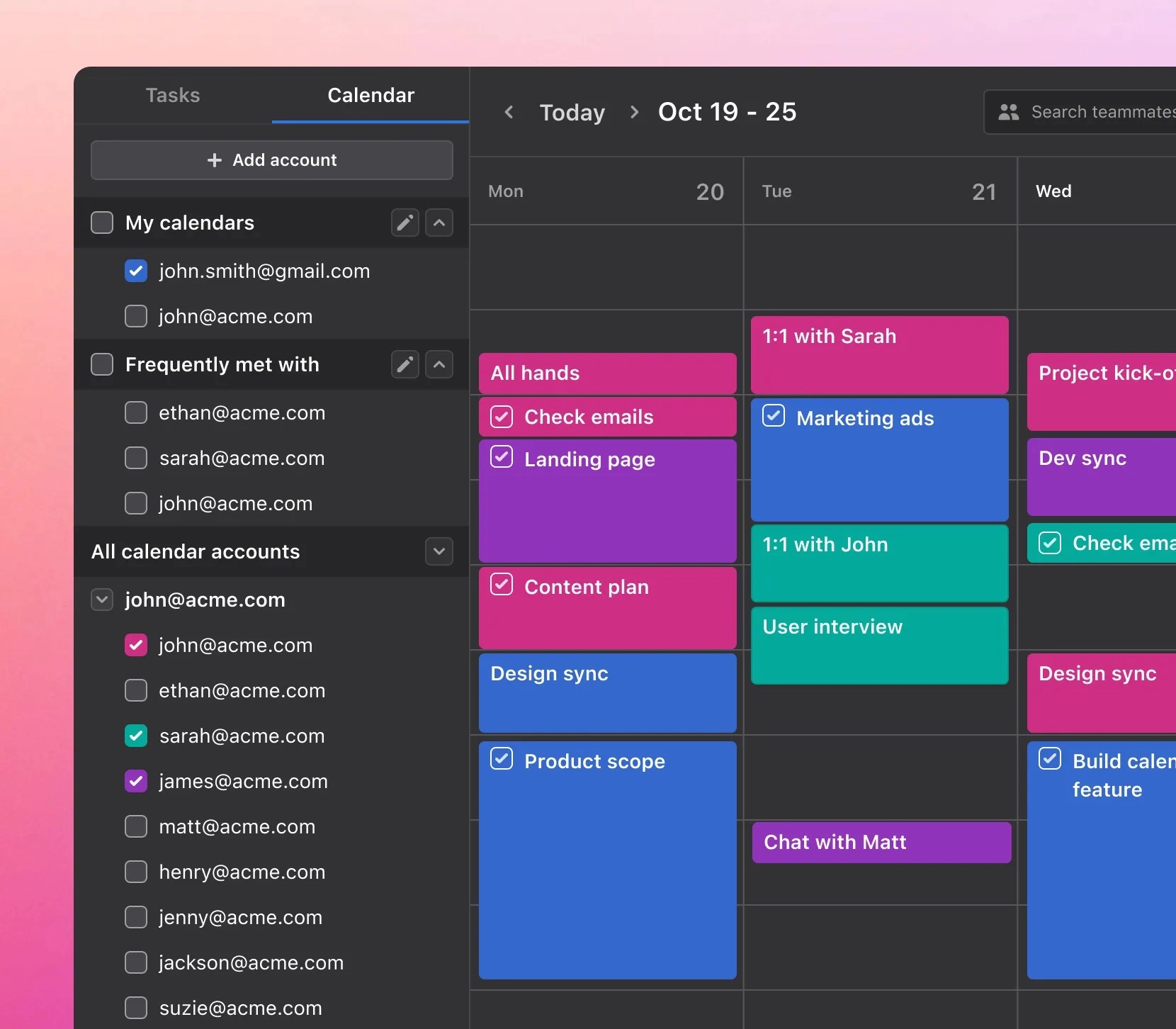 |
7. Adopt a continuous improvement approach
Embrace the principles of Kaizen — the idea of continuous improvement. Kaizen is all about making incremental changes that gradually lead to big results. Adopting this mindset helps businesses streamline their processes and improve their performance.
One way you can implement this practice into your quarterly planning process is to always review and adjust your plans based on performance and feedback.
Let’s say that, for this quarter, you notice that a particular strategy is not generating the expected results. You can then use this as an opportunity to tweak your approach.
A culture of continuous improvement rubs off on every aspect of your business, too. Before long, it will influence everything from your planning processes to your daily operations.
4 quarterly planning methods
Let’s take a look at four types of quarterly planning methods to get you started:
1. General quarterly planning
A general quarterly plan is versatile and suitable for different business sectors or sizes. It includes goal setting, action plans, and performance tracking.
Start with goal setting, and define your SMART goals for the quarter. Next, create an action plan to break those goals down into actionable steps. Remember to assign each task and set deadlines. Finally, create a performance-tracking section in your plan so you can set KPIs to measure your progress against your goals.
2. Agile methodology-based quarterly planning
This method is perfect for teams that implement agile practices. It focuses on sprints, iterative cycles, and regular reviews.
Your sprint goals should always contribute to your quarterly objectives, and your cycles should have clear deliverables. Keeping a backlog will simplify your planning process, as you’ll be able to plan and prioritize the most important next steps.
3. Quarterly planning roadmap
When your planning process is geared toward achieving certain milestones, a roadmap provides a visual that you can follow over the quarter. It emphasizes the plan’s progress by charting key milestones and setting clear timelines.
Visually seeing the projected path allows your team to quickly assess how their actions align with the planned objectives. They can then make adjustments as needed.
4. Quarterly financial review
Financial planning is an important yet tricky part of quarterly planning because it involves predicting future financial conditions and managing resources.
A financial review will help you effectively track your business’s financial performance and budget. It lays the groundwork for budget reviews, revenue tracking, expense analysis, and financial forecasting.
Quickfire Q&A for quarterly planning meetings
Have questions about how to run a quarterly planning meeting? We’ve got you covered.
When should you have a quarterly planning meeting?
Quarterly planning meetings are usually held at the beginning of each quarter. They act as a checkpoint for your team to review the previous quarter, past performance, and challenges and set goals for the upcoming quarter.
Come prepared with data, feedback, and a clear agenda to have a productive discussion. Moreover, use Motion’s Meeting Assistant to templatize and schedule your quarterly planning sessions. That way, you make sure every quarterly meeting is consistent and efficient.
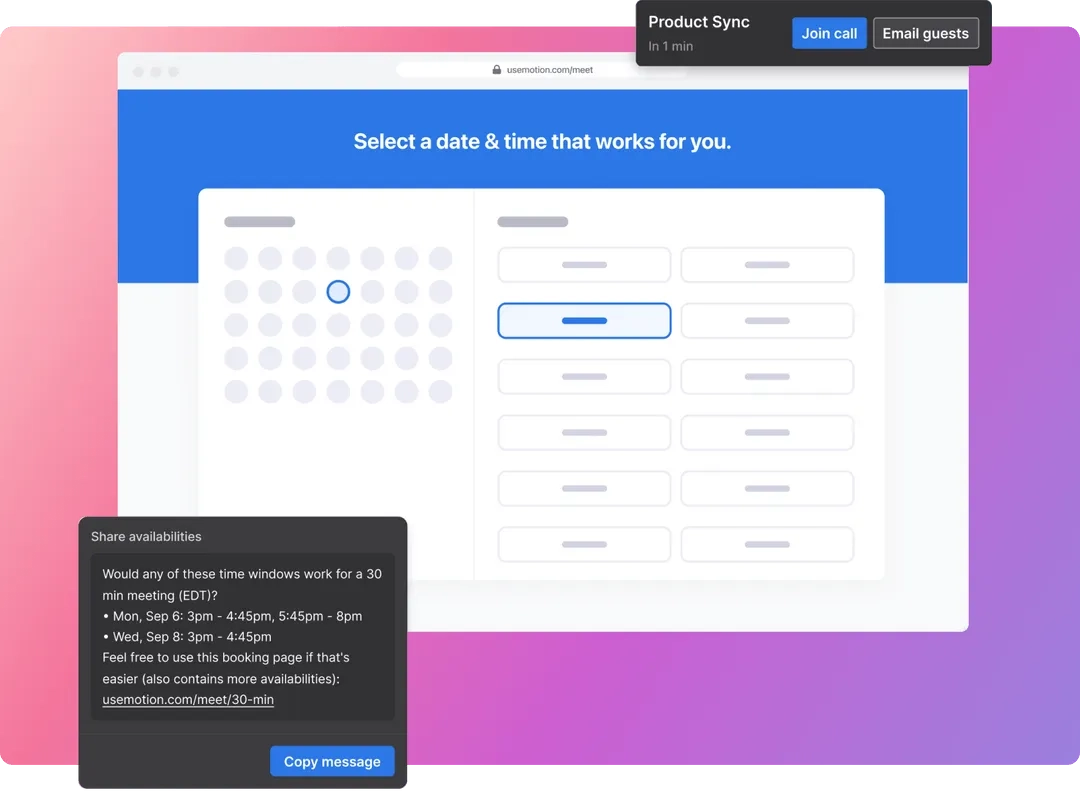 |
How long should a quarterly planning meeting last?
While this depends on each business, these meetings typically last from an hour to a full day. Because quarterly planning meetings often involve comprehensive review and decision-making, you need to give the discussion enough time. However, avoid dragging out the meeting and focusing on minute project details, as this can be counterproductive.
Keep in mind, too, that it’s not helpful to overload your team with information without giving them time to digest everything. If you notice team members starting to check out or feel overwhelmed, take a break.
Who should be at the quarterly planning meeting?
All key stakeholders and decision-makers should be involved in the meeting. This typically includes different department heads, senior management, and other employees. High-level executives may want to have a preliminary meeting before the broader meeting to align the company’s main messages and objectives.
Having employees join your meetings can be especially beneficial because they can provide ground-level insights and feedback.
Keep in mind that each participant should understand their role and responsibility in contributing to the quarterly objectives after the meeting.
How do you keep everyone accountable for tasks?
It’s one thing to have a quarterly planning meeting, but it’s another to get your team to follow through on the commitments made during the meeting.
You need to have action items. Each task should be clearly defined and assigned an owner and a specific timeline so there’s no confusion on who’s doing what and by when.
To save you some time, Motion keeps track of your team’s tasks and project progress. You can quickly see and address any delays. Automated deadline reminders also help the team stay alert and on schedule. Our tools ensure that everyone on the team understands their responsibilities and is held accountable for their part in achieving the quarterly goals.
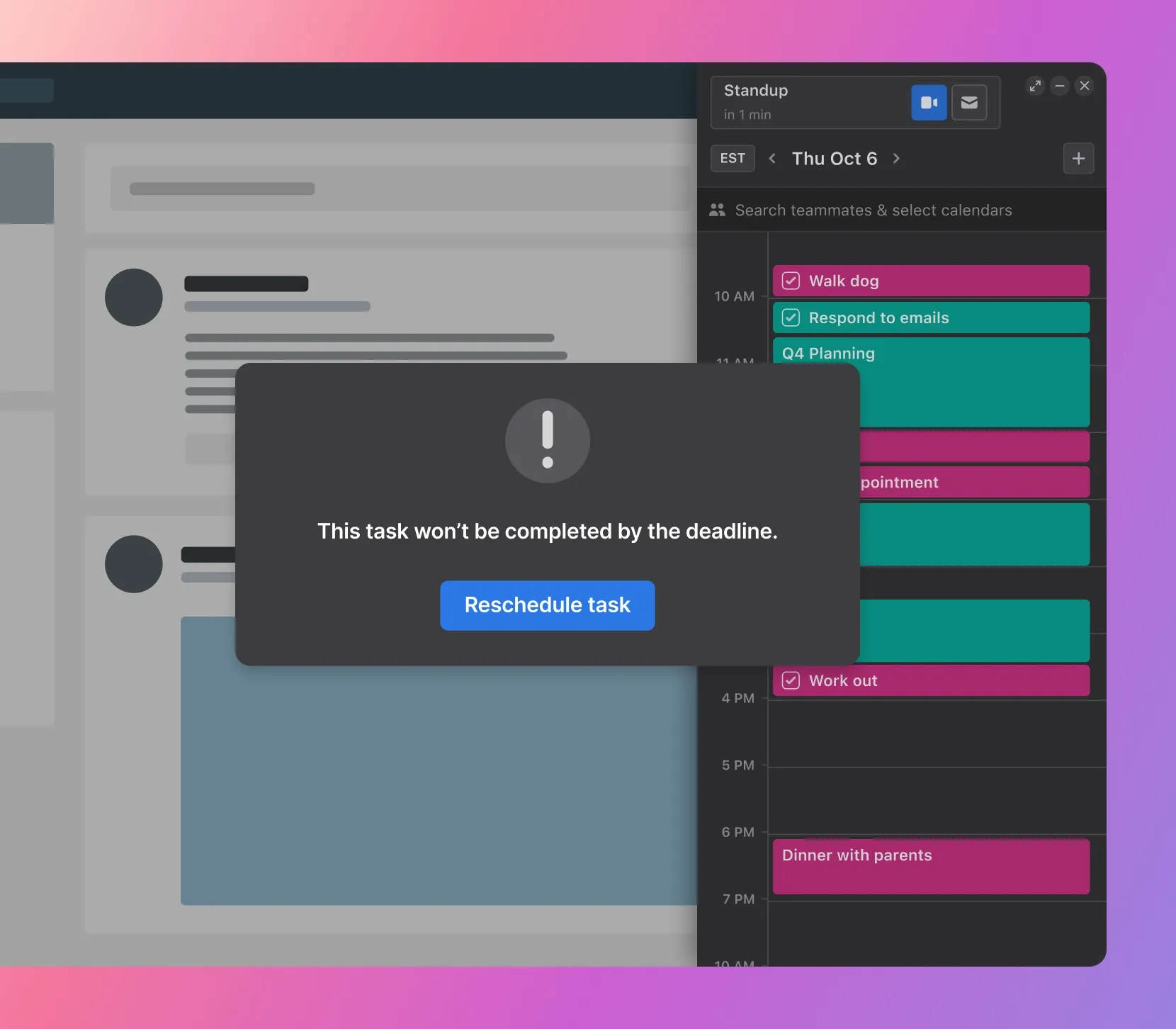 |
Make the most out of your quarterly planning with Motion
You’re not alone this quarterly planning season — you’ve got us. Motion effectively simplifies the quarterly planning process by automating task delegation, enabling progress tracking, and centralizing communication.
Give us a try, and see how different — and improved — your planning process can be.

Vicki Chen is a content writer and marketer using proven storytelling methods to create high-quality copy and content for SaaS companies. When she's not writing, she's spending time with Taco, her rescue dog.




